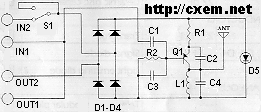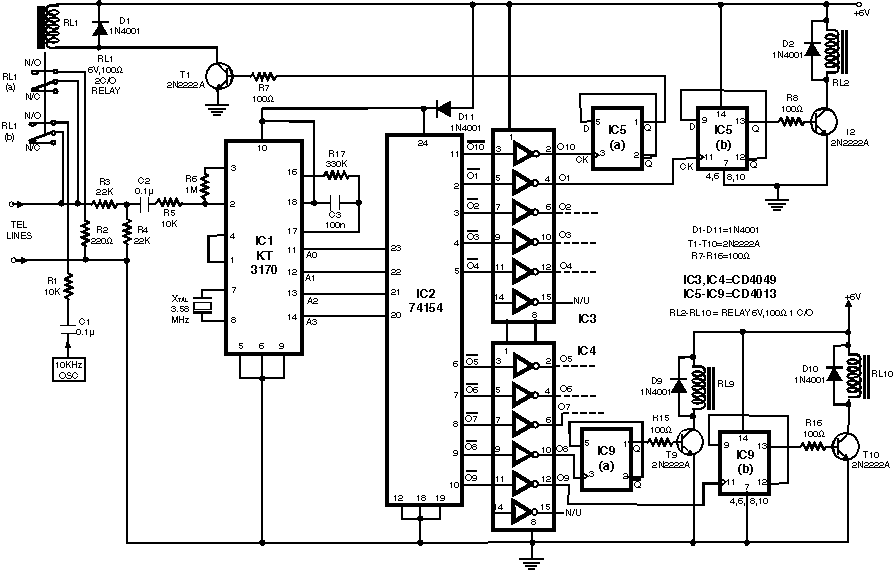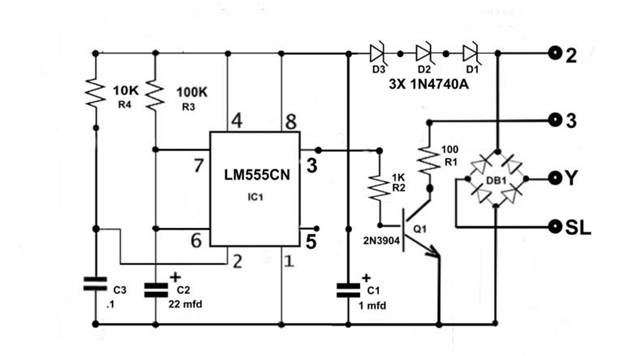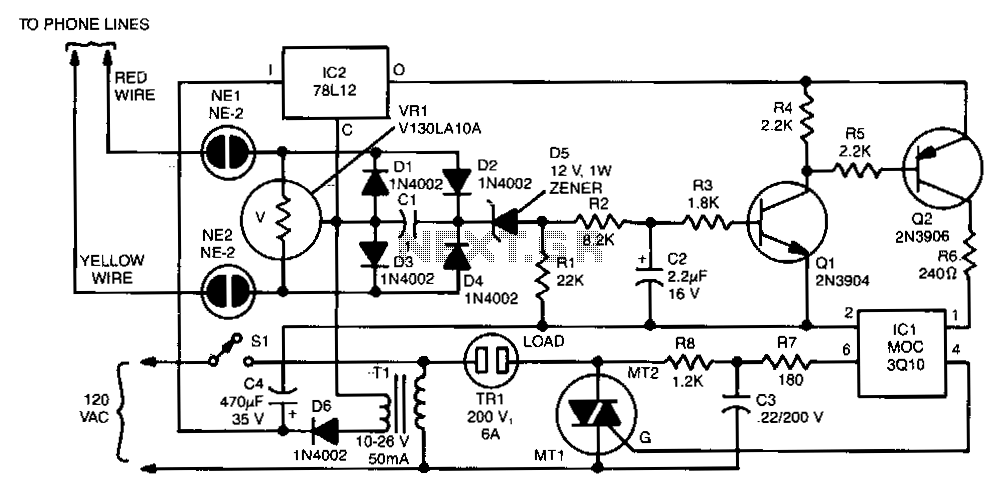
Telephone blinker

A small neon lamp is activated by the telephone's ringing voltage, allowing a sufficient current to flow to the LED in optocoupler U1. This activation subsequently triggers a 6-A Triac that controls a 117-Vac lamp or bell. Capacitor C1 is only required when the circuit is utilized to drive a bell. The lamp will flash on and off at the ringing rate, which typically is around 20 Hz. If a 117-Vac bell is employed, it should be connected in place of the lamp.
The described circuit utilizes a neon lamp as a voltage sensing element that responds to the alternating current (AC) ringing voltage generated by a telephone line. When the phone rings, the neon lamp turns on, allowing current to flow through the LED of optocoupler U1. The optocoupler serves as an isolation barrier, transferring the signal from the low-voltage side to the high-voltage side without direct electrical connection.
The LED within the optocoupler, upon receiving current from the neon lamp, illuminates and triggers the phototransistor inside the optocoupler. This action causes the phototransistor to conduct, effectively closing a switch that activates the gate of the Triac. The Triac is a semiconductor device capable of controlling AC power, and in this configuration, it is rated for 6 Amperes, suitable for driving loads such as a 117-Vac lamp or bell.
In cases where a bell is used instead of a lamp, capacitor C1 is included in the circuit to provide necessary phase shift and stabilization for the Triac operation. The flashing of the lamp or bell occurs at the ringing frequency of the telephone, approximately 20 Hz, creating a visual or audible indication of an incoming call.
To implement this circuit effectively, proper attention must be given to component ratings, ensuring that the Triac can handle the load current and voltage, and that the optocoupler is rated for the necessary isolation voltage. Additionally, the neon lamp should be selected based on its breakdown voltage characteristics to ensure reliable triggering at the ringing voltage. Overall, this circuit provides a simple and effective means to indicate telephone ringing through visual or audible alerts.A small neon lamp is triggered into conduction by the telephone's ringing voltage, passes just enough current to activate the LED in optocoupler Ul, which in turn triggers the 6-A Triac that controls 12—a 117-Vac lamp or bell. (Capacitor Cl is necessary only when the circuit is used to drive a bell.) The lamp will flash off-and-on at the ringing rate, which is normally around 20 Hz.
Ha 117 Vac bell is used, connect it in place of the lamp.
The described circuit utilizes a neon lamp as a voltage sensing element that responds to the alternating current (AC) ringing voltage generated by a telephone line. When the phone rings, the neon lamp turns on, allowing current to flow through the LED of optocoupler U1. The optocoupler serves as an isolation barrier, transferring the signal from the low-voltage side to the high-voltage side without direct electrical connection.
The LED within the optocoupler, upon receiving current from the neon lamp, illuminates and triggers the phototransistor inside the optocoupler. This action causes the phototransistor to conduct, effectively closing a switch that activates the gate of the Triac. The Triac is a semiconductor device capable of controlling AC power, and in this configuration, it is rated for 6 Amperes, suitable for driving loads such as a 117-Vac lamp or bell.
In cases where a bell is used instead of a lamp, capacitor C1 is included in the circuit to provide necessary phase shift and stabilization for the Triac operation. The flashing of the lamp or bell occurs at the ringing frequency of the telephone, approximately 20 Hz, creating a visual or audible indication of an incoming call.
To implement this circuit effectively, proper attention must be given to component ratings, ensuring that the Triac can handle the load current and voltage, and that the optocoupler is rated for the necessary isolation voltage. Additionally, the neon lamp should be selected based on its breakdown voltage characteristics to ensure reliable triggering at the ringing voltage. Overall, this circuit provides a simple and effective means to indicate telephone ringing through visual or audible alerts.A small neon lamp is triggered into conduction by the telephone's ringing voltage, passes just enough current to activate the LED in optocoupler Ul, which in turn triggers the 6-A Triac that controls 12—a 117-Vac lamp or bell. (Capacitor Cl is necessary only when the circuit is used to drive a bell.) The lamp will flash off-and-on at the ringing rate, which is normally around 20 Hz.
Ha 117 Vac bell is used, connect it in place of the lamp.





